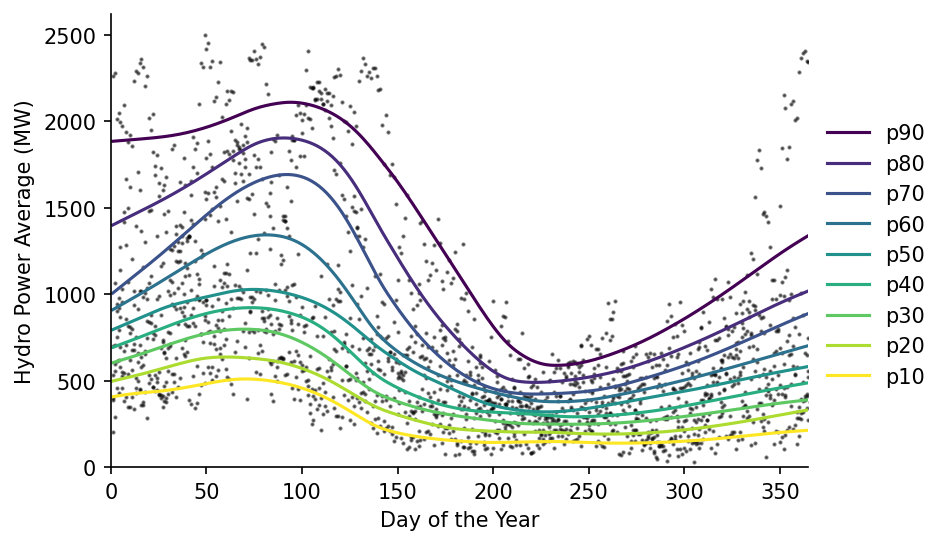Quantile Estimation of Portugese Hydro Power Seasonality¶
In this example we'll use power output data from Portugese hydro-plants to demonstrate how the quantile LOWESS model can be used.
Imports¶
import pandas as pd
import matplotlib.pyplot as plt
from moepy import lowess, eda
Loading Data¶
We'll start by reading in the Portugese hydro output data
df_portugal_hydro = pd.read_csv('../data/lowess_examples/portugese_hydro.csv')
df_portugal_hydro.index = pd.to_datetime(df_portugal_hydro['datetime'])
df_portugal_hydro = df_portugal_hydro.drop(columns='datetime')
df_portugal_hydro['day_of_the_year'] = df_portugal_hydro.index.dayofyear
df_portugal_hydro = df_portugal_hydro.resample('D').mean()
df_portugal_hydro = df_portugal_hydro.rename(columns={'power_MW': 'average_power_MW'})
df_portugal_hydro.head()
| datetime | average_power_MW | day_of_the_year |
|---|---|---|
| 2015-01-01 | 698.5 | 1 |
| 2015-01-02 | 1065.75 | 2 |
| 2015-01-03 | 905.125 | 3 |
| 2015-01-04 | 795.708 | 4 |
| 2015-01-05 | 1141.62 | 5 |
Quantile LOWESS¶
We now just need to feed this data into our quantile_model wrapper
# Estimating the quantiles
df_quantiles = lowess.quantile_model(df_portugal_hydro['day_of_the_year'].values,
df_portugal_hydro['average_power_MW'].values,
frac=0.4, num_fits=40)
# Cleaning names and sorting for plotting
df_quantiles.columns = [f'p{int(col*100)}' for col in df_quantiles.columns]
df_quantiles = df_quantiles[df_quantiles.columns[::-1]]
df_quantiles.head()
100%
9/9
[00:16<00:02, 1.73s/it]
| x | p90 | p80 | p70 | p60 | p50 | p40 | p30 | p20 | p10 |
|---|---|---|---|---|---|---|---|---|---|
| 1 | 1885.08 | 1400.78 | 1006.97 | 910.769 | 795.475 | 693.001 | 604.221 | 498.096 | 407.17 |
| 2 | 1885.93 | 1406.29 | 1015.76 | 917.074 | 800.255 | 697.121 | 607.521 | 500.673 | 409.021 |
| 3 | 1886.8 | 1411.81 | 1024.54 | 923.37 | 805.008 | 701.225 | 610.814 | 503.239 | 410.866 |
| 4 | 1887.68 | 1417.32 | 1033.31 | 929.659 | 809.738 | 705.317 | 614.105 | 505.797 | 412.695 |
| 5 | 1888.57 | 1422.84 | 1042.08 | 935.952 | 814.456 | 709.409 | 617.404 | 508.359 | 414.485 |
We can then visualise the estimated quantile fits of the data
fig, ax = plt.subplots(dpi=150)
ax.scatter(df_portugal_hydro['day_of_the_year'], df_portugal_hydro['average_power_MW'], s=1, color='k', alpha=0.5)
df_quantiles.plot(cmap='viridis', legend=False, ax=ax)
eda.hide_spines(ax)
ax.legend(frameon=False, bbox_to_anchor=(1, 0.8))
ax.set_xlabel('Day of the Year')
ax.set_ylabel('Hydro Power Average (MW)')
ax.set_xlim(0, 365)
ax.set_ylim(0)
(0.0, 2620.8375)

We can also ask questions like: "what day of a standard year would the lowest power output be recorded?"
scenario = 'p50'
print(f'In a {scenario} year the lowest hydro power output will most likely fall on day {df_quantiles[scenario].idxmin()}')
In a p50 year the lowest hydro power output will most likely fall on day 228
We can also identify the peridos when our predictions will have the greatest uncertainty
s_80pct_pred_intvl = df_quantiles['p90'] - df_quantiles['p10']
print(f'Day {s_80pct_pred_intvl.idxmax()} is most likely to have the greatest variation in hydro power output')
# Plotting
fig, ax = plt.subplots(dpi=150)
s_80pct_pred_intvl.plot(ax=ax)
eda.hide_spines(ax)
ax.set_xlabel('Day of the Year')
ax.set_ylabel('Hydro Power Output 80%\nPrediction Interval Size (MW)')
ax.set_xlim(0, 365)
ax.set_ylim(0)
Day 115 is most likely to have the greatest variation in hydro power output
(0.0, 1724.0724938300584)
